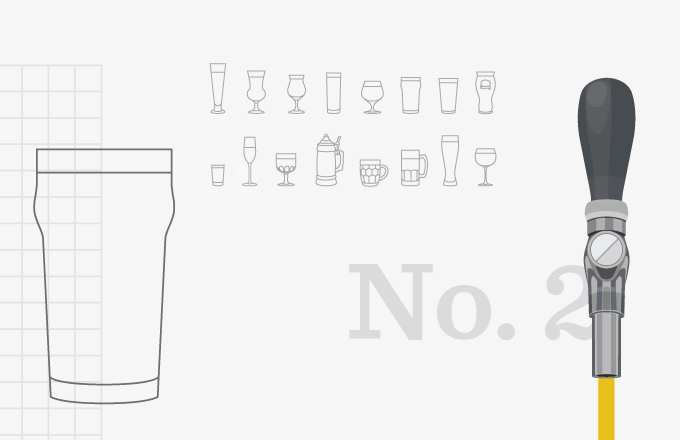

Even if you choose a quality beer and pour the perfect foam head, if you don’t consider your glassware, you’re limiting the beer-drinking experience. Many beer experts believe that unique glassware can have a variety of effects on the the beer drinking experience.
According to the popular website, Beeradvocate:
“As soon as the beer hits the glass, its color, aroma and taste is altered, your eye candy receptors tune in, and your anticipation is tweaked. Hidden nuances become more pronounced, colors shimmer, and the enjoyment of the beer simply becomes a better, more complete experience.”
Experts like Ray Daniels, the creator and director of the Cicerone Certification Program and president of the Craft Beer Institute, agree that glass- ware is essential for an elevated beer-drinking experience.
If a customer asks for an imperial stout, do you know what glass to pour it in? What if he orders a saison or a hop-forward beer?
Start Your Free Trial With Bevspot Today!
Wondering what terms to use to describe the different parts of a basic beer glass how these parts relate to the beer it contains?
When you serve a beer, the head sits at the top near the lip or mouth of the glass and the body of the beer takes up the body or bowl of the glass. The base of the glass keeps the beer steady and upright when it’s placed down on the bar or table. Although the shape and size of beer glassware can widely vary, every beer glass can be identified by these three basic parts.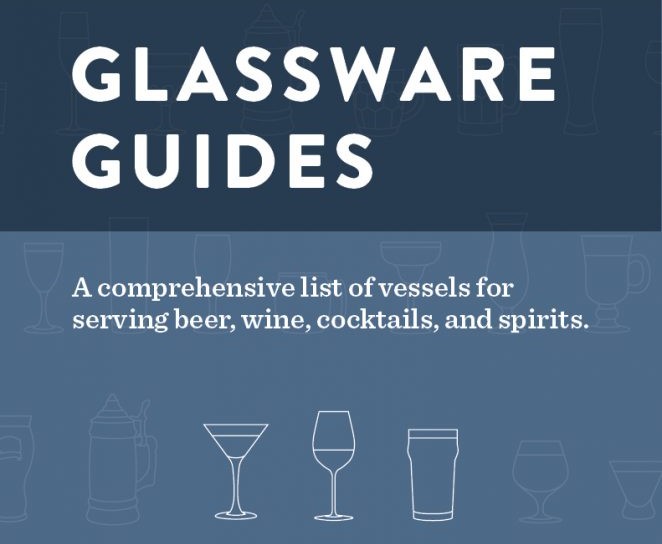
Are you ready to dive into the specifics of beer glassware? Don’t worry, your bar doesn’t necessarily need to be stocked with every single one of these. However, if you identify as a craft beer bar, you might want to consider it. This is a great way to start thinking about how you can create an elevated drinking experience that customers will want to come back for.
Stop serving every beer in the same glass! Take a look at the list below to diversify your beer glass collection.

The pint glass, or the standard pub shaker, gets a bad rap among most beer enthusiasts. These glasses weren’t intend- ed for beer. They were originally used behind the bar to shake cocktails. In the post-prohibition era when American beers were less alcoholic and bland, people started using the pint glass for beer. This practice stuck.
If you’re serving a finely crafted beer in a pint glass, your cus- tomer’s grip will warm the beer very quickly and he won’t fully experience the full aroma or the proper head. With many craft beers these days coming in around 8% ABV, filling up a stan- dard pint glass would be a bit over the top.
Although the pint glass is often criticized, it remains a staple of the American bar scene because it is durable, stackable, easy to clean, and beer companies often provide them free of charge. If you’re trying to use these bad boys, grab one when a patron orders an easy going beer like an Amber Ale, Pale Ale, American Lager or Bocks.
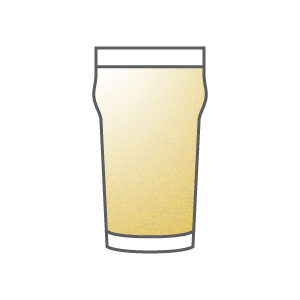
This glass is similar to the shaker pint glass but it’s slightly more fancy. It has a protruding ring near the top to help with handing and to develop a more substantial head than a shaker pint. By concentrating the aromas of the beer in the head, the first sip is more fragrant. This glass is best used for most American and English styles like Stouts, Pilsners, Brown Ales, and Porters.
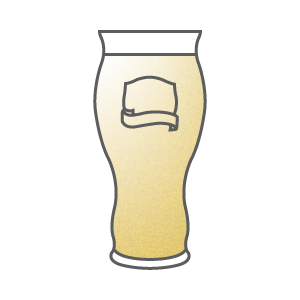
Specifically designed to hold Sam Adams Boston Lager, this glass offers beer lovers “a full sensory drinking experience.” The outward turn of the lip places the beer at the very front of a drinker’s palate to maximize the malt’s sweetness. The narrow top helps to retain the hop aroma and sustain the head. With thinner walls and a rounder shape, the right beer temperature is maintained and the aromas are gathered in a single place. Finally, the bottom of the glass features a nucleation site (laser etchings) that creates bubbles for a consistent aroma release.

Also used for brandy and cognac, this glass has a wide bowl, a tapered mouth, and a stem to help capture the aromas and volatiles of stronger beers. Their shape helps to keep all the aroma in and enhances the nose of malty, complex brews that are usually strong and high in alcohol (ex. anything that starts with Imperial or Double).
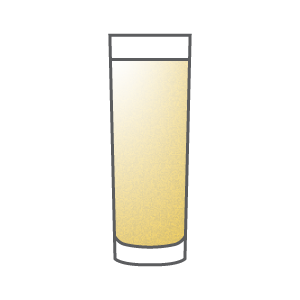
This glass originated in Cologne, Germany. It is most often used for Kolsch beer, a style native to Cologne, and it is designed to fit into a tray used by waiters at Cologne beer halls and pubs. The German word, stange, means “stick.” This glass is similar to a pint glass because it is narrow and cylindrical. However, it’s more slim than an average pint glass, helping to preserve the beer’s aroma and to amplify hop and malt nuances. In addition to traditional Cologne beers, the Stange is also used for Altbiers, Bocks, and more delicate beers.
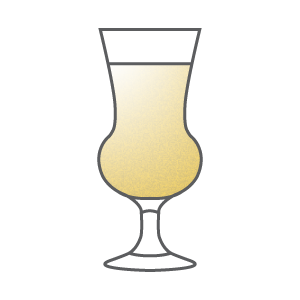
Similar to the Tulip glass, the thistle glass has a stem and a bulb-like bowl. However, this glass is a bit taller and is less curvy around the lip. It was specifically designed for Scottish Ales because Scotland’s official flower is a thistle. It’s also used for strong brews like Belgian ales, and Double IPAs. The bulb-like bowl lets drinkers swirl around the beer so they can help release the full aromas.

The Pilsner glass holds 12 ounces of beer, making it smaller than some of the other glasses on the list. It has triangular dimensions (almost like a trumpet) to help capture the sparkling colors of Pilsners and other wheat beers while still retaining their head.

This glass is best used for strong, high gravity beers and Belgian Ales. The size of this glass allows for headspace and the bowl helps to create an awesome nose. This glass works much like a Tulip or Goblet.
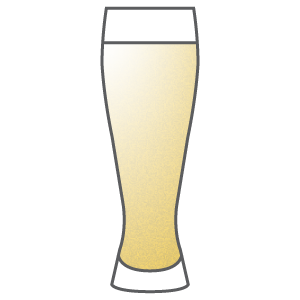
The Wheat Beer glass is much taller than a standard pint glass. It starts out skinny and widens slightly at the top and it has thin, lengthy walls to help showcase the beer’s color. This glass is designed to leave room for headspace, which is necessary for the fluffy head of wheat beers. The design also helps to lock in the banana aromas.

Usually the glass of choice at beer halls, this mug is large, durable, and meant to hold a ton of beer. Since the main purpose of this glass is usually drinking large quantities with a group of friends, this glass doesn’t focus on bringing out the clarity, carbonation, or aroma of specific beers. It has a large handle for easy-gripping and it’s tough enough to take a good clink.

Once popular for its grenade-like appearance, this old-style glass nearly disappeared in the early 2000s. However, it is back in use. An old British tradition, this jug has dimpled sides, a wide mouth, thick glass, and a sturdy handle. It is believed the dimple pattern was introduced merely to use less glass in production. The mug’s thick walls help to keep it cool and the handle is great for easy gripping. Many like to drink from them because of their heritage and “old-school coolness.” Although they are back for now, not everyone is a fan. Some drinkers think the mug is too clunky and has poor head retention and bartenders have trouble storing them because they can’t be stacked.

Often confused with a mug, the beer stein is the same shape but it has a hinged lid. Traditionally, steins were made with a variety of materials like stoneware, silver, wood, and porcelain. This glass originated because it was believed that a lid would make more drinking more sanitary and prevent the bubonic plague. Today, people still use these glasses but they are more like an ornamental or souvenir glass.

A goblet is delicate and long stemmed and a chalice is heavy and thick walled. Other than looking super majestic, this type of glass is great for head retention, deep sips, and analyzing aromas. Unlike other glassware, these glasses are found in a variety of sizes. They’re best suited for heavy, malty beers like German Bocks and Belgian Ales.
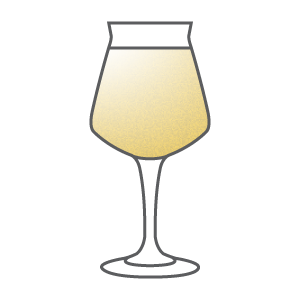
Designed by an Italian top craft beer brewer and a sensory analyst, the TeKu glass is supposed to improve the craft beer drinking experience. Although it was originally created and branded for the Baladin brewery, it quickly grew in popularity and is now widely recognized as one of the top beer glasses today.
The glass has a unique shape. It’s almost a hybrid of a long-stemmed wine glass but it’s designed to capture and release a beer’s aromas in its outward curve and thin glass. It’s been called the true glass for beer geeks.

In addition to holding champagne, this glass’s long and narrow body ensures that beer’s carbonation doesn’t dissipate too quickly. It also showcases the carbonation and color and helps to quickly release volatiles to provide a more intense upfront aroma. Sometimes the stem is a bit shorter than a regular champagne flute, but not always. Use this glass when pouring a Pilsner or a beer that emulates wine.

These types of glasses are used for, you guessed it, sampling and tasting. These glasses come in different sizes and shapes and they hold only a small amount of beer so you can sample multiple beers without getting intoxicated. You’ll often see breweries using these types of glasses as well as your local pub.
